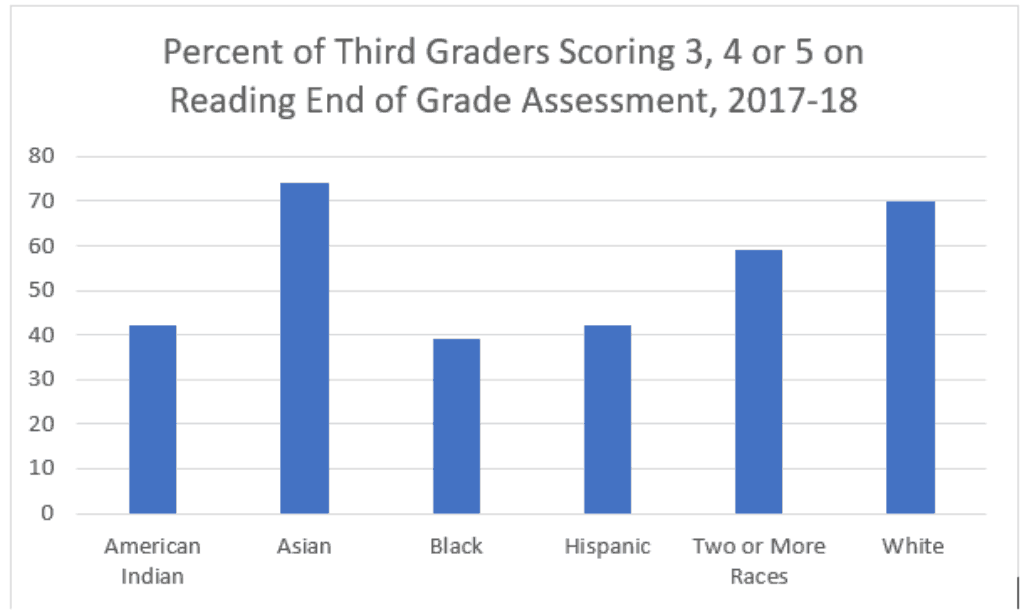The most recent NC end of third grade reading assessment results show scores hardly shifting from last year and continued racial, ethnic, and socioeconomic gaps. What can we do differently? A recent research study on how best to reduce achievement disparities in diverse schools finds that a comprehensive set of strategies is needed – a message that supports the Pathways to Grade-Level Reading initiative’s call for a whole-child, cross-sector approach.
On the 2017-18 reading end-of-grade test (EOG), 56 percent of NC third-graders scored “grade-level proficient,” or a 3, 4, or 5, as compared with 58 percent the previous two years. Echoing results from the last couple years, girls outpaced boys, 59 percent to 53 percent. Only 41 percent of children from economically disadvantaged families, 31 percent of students with limited English proficiency, and 23 percent of students with disabilities were deemed proficient, also on par with the last two years. More than 95 percent of students with the designation of “academically and intellectual gifted” (AIG) scored a 3, 4 or 5.
Racial and ethnic gaps have also persisted year to year. This year’s results are noted on the chart below by race and ethnicity, with the largest gap between Asian students (74 percent proficient) and Black students (39 percent proficient).

How can we do better?
Research shows that a broad portfolio of investments in children and families is what is needed to move the needle on third grade reading proficiency. It isn’t just about the teacher, the curriculum, or the specific reading intervention—it’s also about food security, preventive health visits, and stable housing. The NC Pathways to Grade-Level Reading initiative has developed a set of whole-child measures of success and drafted a cross-sector Action Framework with recommendations for improving outcomes on the measures that matter for third grade reading proficiency.
The whole child approach to improving achievement and reducing disparities received another boost with a recent publication from Public Impact. Closing Achievement Gaps in Diverse Schools: An Action Guide for District Leaders is a meta-analysis of 150 studies over the past 10 years, with a focus on studies that include a quantitative analysis of impact on students.
Based on the research findings, the study recommends a comprehensive, cross-sector approach to reduce disparities in achievement. Recommendations include education-specific strategies, as well as supports for children’s health and meeting families’ basic needs. The findings also stress the importance of a culture of racial equity. Specific recommendations, as outlined in this EdNC article, include:
Outstanding learning for all
- Guaranteeing excellent teachers and principals
- Ensuring access to high-standards materials and learning opportunities.
- Using teaching methods and school practices that work, including screening for and addressing learning differences, personalizing instruction, and responding to trauma.
Secure and healthy learners
- Meeting basic needs, including meals and reducing school transitions from housing changes.
- Fostering wellness and joy via school-based health clinics, social-emotional learning, and other building blocks of academic success, and addressing mental health challenges.
- Supporting families by understanding and responding to individual and collective needs.
Culture of equity
- Addressing key equity challenges in schools, including teachers matching their students’ racial and other identities, access to advanced opportunities, culturally relevant assignments, and research-based, non-discriminatory disciplinary policies.
- Fostering community accountability via shared leadership that truly empowers.
- Equipping individuals to act by developing leadership and addressing implicit bias via consistent, ongoing anti-bias training.
The report also recommends that districts make public commitments to closing gaps and achieving equity, with clear, measurable goals; that they engage communities and families in the effort; that they implement their commitments; and that they embrace accountability.
Public Impact’s research-based recommendations align with the Pathways Design Team’s draft Action Framework, which will be shared publicly in late October. The Framework outlines expectations for NC’s child and family systems, and recommends actions the state and other actors can take to improve outcomes in three areas that impact third grade reading proficiency – children’s social-emotional health, high quality birth-through-age-eight care and education, and regular school attendance. The Action Framework uses a racial equity lens, and proposes that equity and learning from and engaging families are critical twin pillars for a successful approach. The Framework also stresses that children live in the context of their families and communities, and meeting family needs is essential for children’s success.
Pathways’ vision is that all North Carolina children, regardless of race, ethnicity or socioeconomic status, are reading on grade-level by the end of third grade, and all children with disabilities achieve expressive and receptive communication skills commensurate with their developmental ages, so that they have the greatest opportunity for life success.
Together, we can accomplish that vision, with aligned policies and practices that ensure children’s health and development, beginning at birth; supported and supportive families and communities; and high-quality birth-through-age-eight learning environments, with regular attendance.



